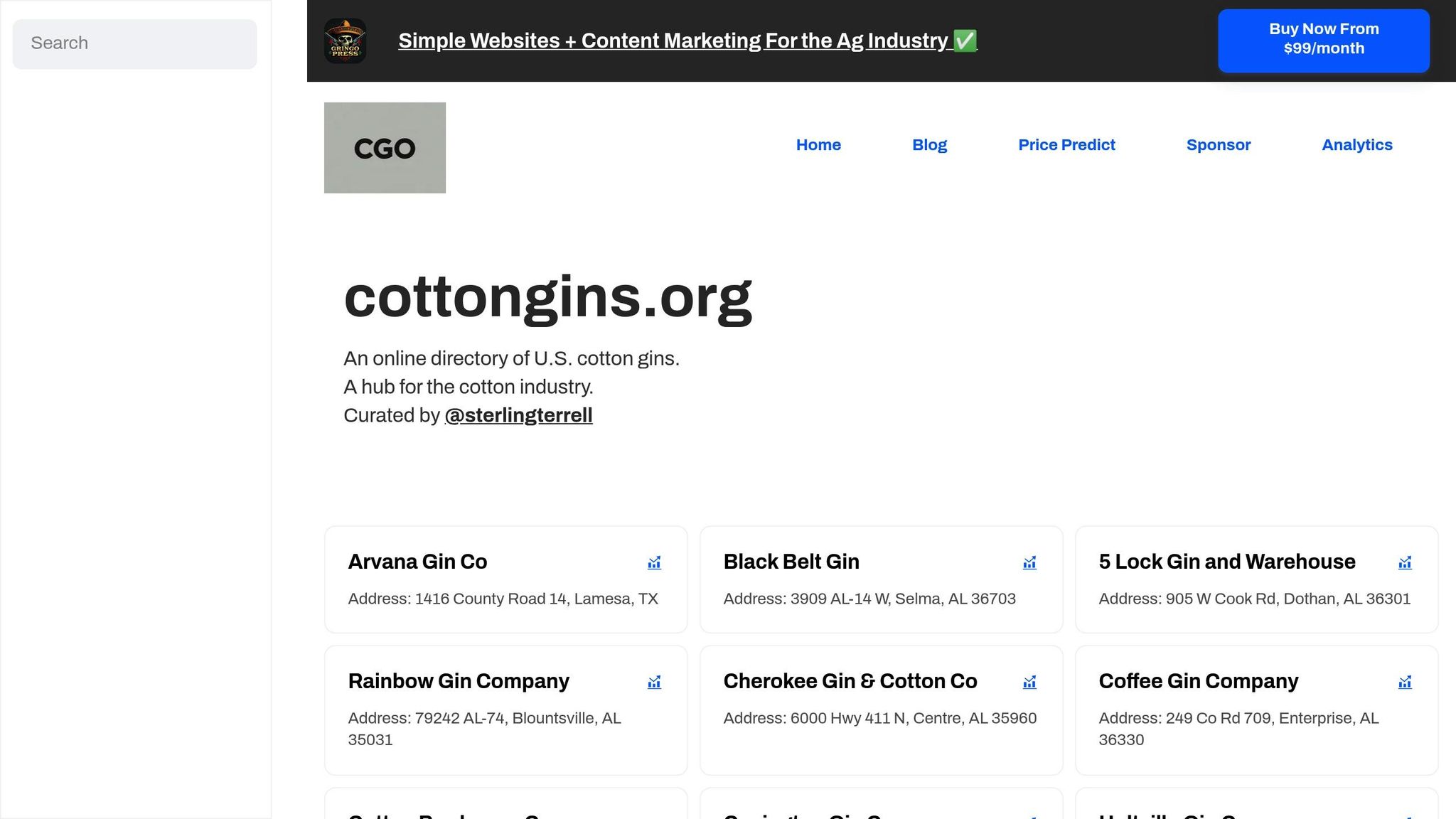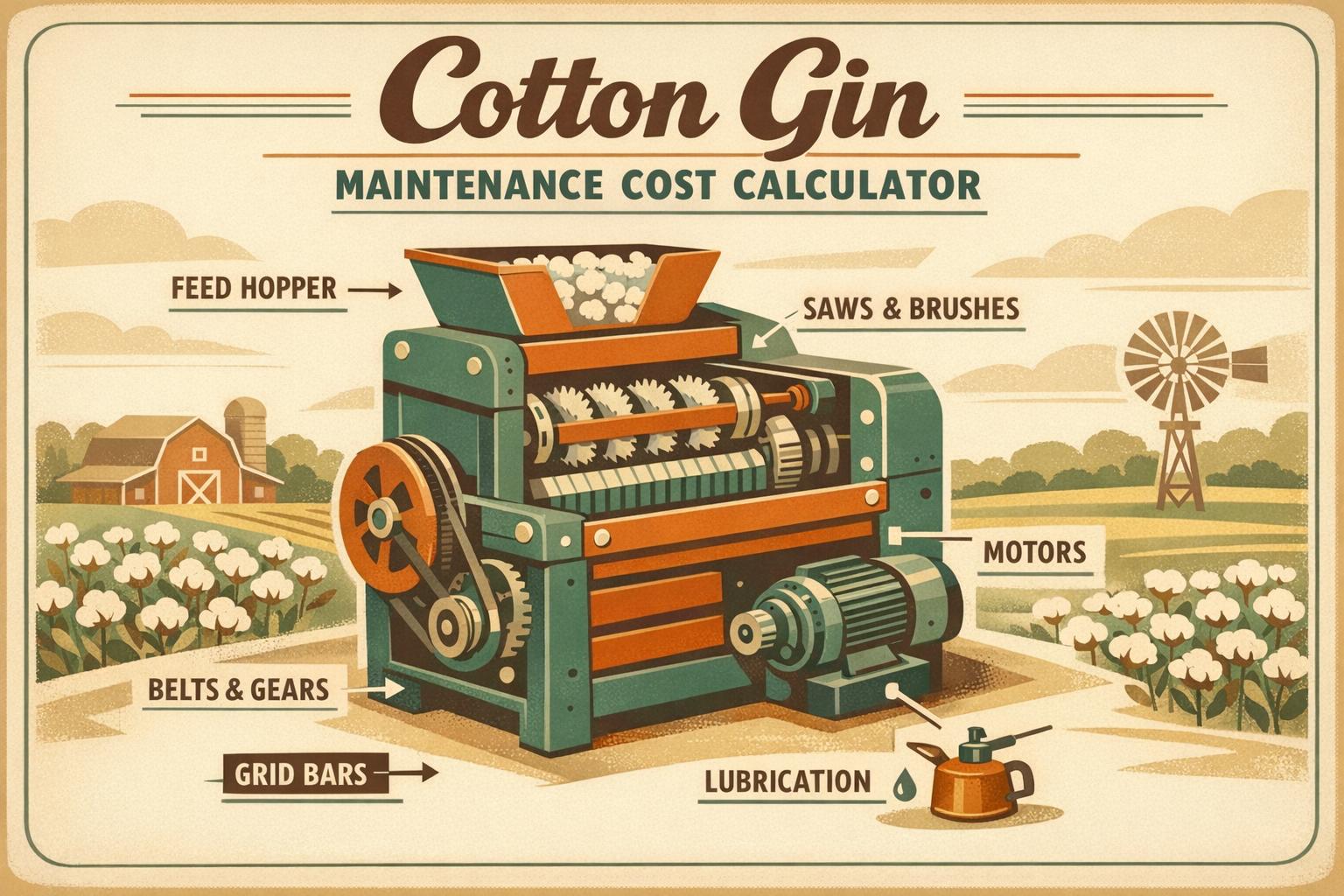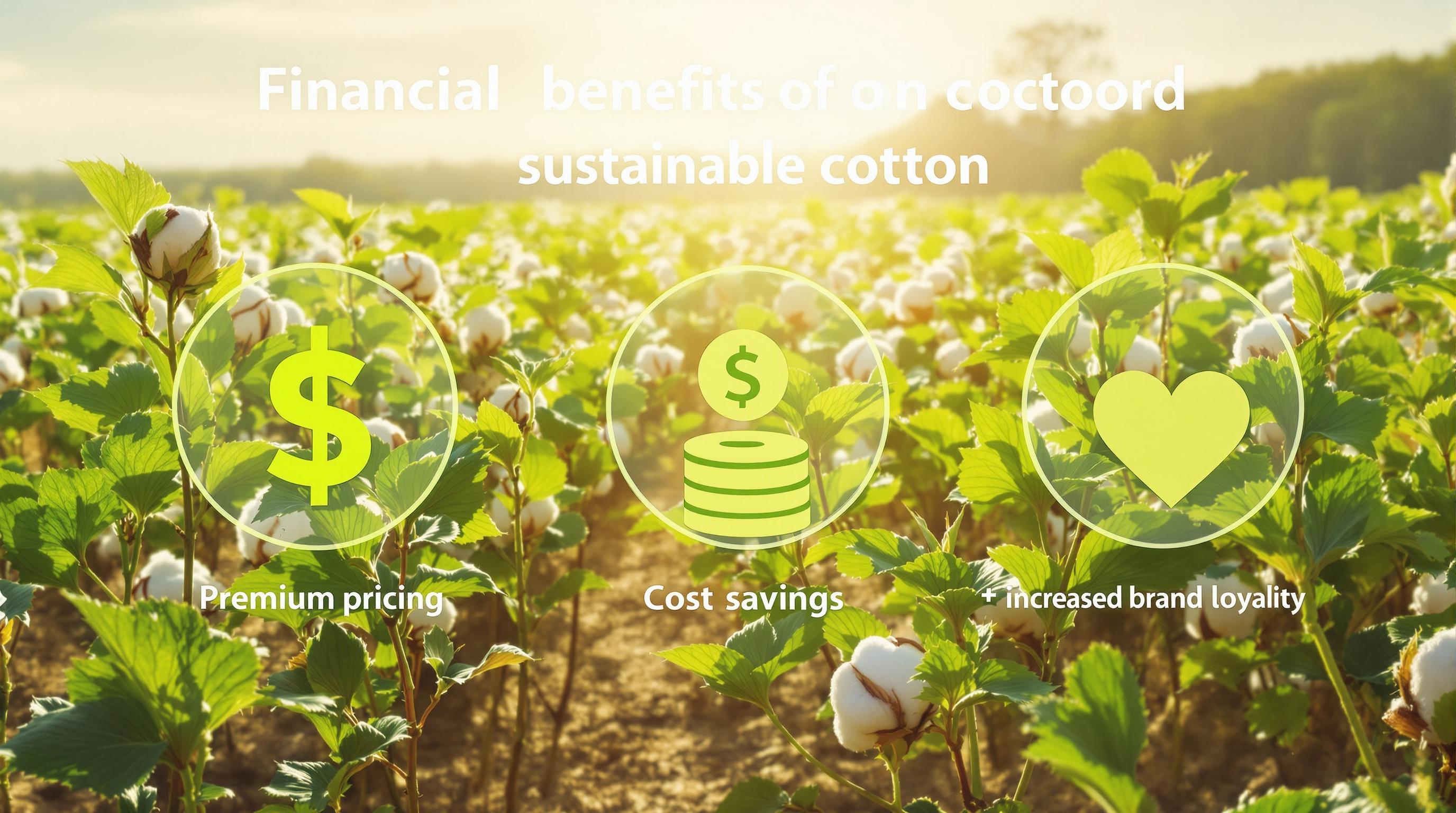Timing your cotton harvest is a balancing act between maximizing yield and avoiding weather-related risks. Relying on growing degree days (GDD) provides a precise, temperature-based method to determine crop maturity, replacing less reliable calendar dates or visual inspections. Here's what you need to know:
- GDD Basics: Tracks the accumulated heat (base temperature 60°F) to monitor cotton growth stages.
- Key Growth Stages:
- Emergence: ~50-100 GDD
- Squaring: 350-450 GDD
- First Bloom: 750-850 GDD
- Boll Development: 1,900-2,100 GDD
- Harvest Readiness: 2,000-2,400 GDD
- Daily Calculation: Average daily temperature minus 60°F equals GDD for that day.
- Benefits: Aligns harvest timing with actual weather, improves yield and fiber quality, and helps plan logistics.
GDD offers a reliable way to predict maturity, adjust for regional climate differences, and avoid risks from extreme weather. By tracking GDD, you can make informed decisions and ensure a profitable harvest.
What Are Growing Degree Days in Cotton Farming
Growing Degree Days Explained
Growing degree days (GDD) measure the accumulated heat cotton plants receive throughout their growing season. Think of GDD as a way to track the heat energy available for cotton growth, helping farmers monitor and predict crop development.
For cotton, the calculation starts with a base temperature of 60°F - the minimum temperature needed for the plants to grow. If the temperature dips below 60°F, growth essentially pauses, and no degree days are added.
Here’s how it works: If today’s average temperature is 80°F, your crop accumulates 20 degree days (80°F - 60°F = 20). If tomorrow averages 75°F, you add another 15 degree days to the total. This process continues throughout the season, giving you a running total of accumulated heat.
What makes GDD especially useful is its ability to account for seasonal temperature shifts. Unlike fixed calendar dates, GDD adjusts to conditions like cooler springs or hotter-than-usual summers. For example, whether a cotton plant reaches 2,000 degree days on August 15 during a cooler year or July 25 in a hotter one, it will likely be at the same developmental stage. This flexibility ensures accurate tracking, no matter the weather.
Cotton Growth Stages and GDD Needs
Tracking GDD helps pinpoint key growth stages in cotton plants, making it easier to plan your harvest and manage resources efficiently. Cotton grows through several distinct phases, each requiring a specific amount of accumulated heat before moving to the next stage.
- Emergence: This occurs at around 50-100 GDD after planting, depending on factors like soil temperature and seed depth. Emergence marks the beginning of seedling growth.
- Squaring: At 350-450 GDD, plants start forming flower buds. This stage signals the shift from vegetative growth to reproductive development, setting the stage for flowering and, ultimately, your harvest.
- First Bloom: Flowers typically appear at 750-850 GDD, starting the pollination process. This milestone gives you a rough timeline for when bolls will begin forming.
- Boll Development: From first bloom through 1,900-2,100 GDD, cotton fibers develop inside the protective boll casing. The quality and quantity of fiber produced during this stage have a direct impact on your harvest’s value.
- Harvest Readiness: By 2,000-2,400 GDD, bolls have opened, and the fibers have reached their ideal length and strength. This is the point when cotton is ready for harvesting, though the exact timing depends on the variety and growing conditions.
These GDD benchmarks are far more precise than relying on calendar dates or visual cues alone. For example, if your field has accumulated 2,200 degree days, it’s likely ready for harvest evaluation - even if the timing feels earlier or later than usual. This level of precision helps you coordinate with cotton gins and schedule equipment to maximize yield and fiber quality.
How to Calculate and Track Degree Days
Daily GDD Calculation Method
Calculating growing degree days (GDD) for cotton involves a simple formula that uses daily temperature readings. The formula is:
((Maximum Temperature + Minimum Temperature) ÷ 2) – 60°F
All temperatures are measured in Fahrenheit. Here's an example: if the day's high temperature is 88°F and the low is 72°F, the average temperature would be (88°F + 72°F) ÷ 2 = 80°F. Subtract the base temperature of 60°F, and you get 20 degree days for that day. If the average temperature falls below 60°F, record zero degree days because cotton growth significantly slows or stops below this threshold. This is why 60°F is used as the base temperature for Degree Day 60s (DD60s).
Keeping accurate daily GDD records is essential for monitoring the development of cotton crops. By consistently tracking GDD, you can better anticipate critical growth stages and make informed decisions about harvest timing.
Using GDD for Better Cotton Harvest Timing
Predicting Crop Maturity with GDD
Growing degree days (GDD) provide a reliable way to predict when cotton crops will hit critical harvest stages. By keeping track of GDD accumulation throughout the growing season, you can better anticipate key events like boll opening and the best timing for defoliation - something that calendar dates alone can’t guarantee.
Research conducted in the U.S. Southern High Plains reveals that cotton yields are optimized when summer GDD accumulation reaches 2,610°F.
The timing of GDD accumulation directly impacts both yield and quality. If GDD levels lag behind typical patterns, it could signal delays in crop maturity, which might disrupt your harvest schedule. Having this data on hand allows you to make timely adjustments to field operations.
Weather plays a huge role during the boll development phase. For example, in 2017, the Southern High Plains experienced unusually wet and cool conditions during this critical period. The result? Immature crops and a significant drop in quality.
At the Lubbock classing office, 47% of tested bales fell into the micronaire discount category (below 3.5), reducing USDA loan program lint values by at least $0.02 per pound.
This example highlights how inadequate GDD accumulation during key growth phases can directly lead to financial setbacks.
Defoliation should begin when GDD data indicates boll maturity. Proper timing helps ensure maximum fiber quality while avoiding the risks of premature harvesting, which could hurt both yield and fiber characteristics.
Adjusting for Regional and Seasonal Differences
Regional and seasonal variations mean that GDD benchmarks aren’t one-size-fits-all. Different geographic areas experience unique temperature patterns, so you’ll need to tweak standard GDD targets to match local conditions. Monitoring daily GDD remains essential for adapting to these differences.
Planting dates play a major role in GDD accumulation and, ultimately, harvest outcomes.
Studies show that in the Southern High Plains, planting in May led to significantly higher lint yields in 8 out of 10 years compared to planting in June.
Earlier planting gives crops more time to accumulate GDD during the most favorable temperature windows, promoting better fiber development and higher yields.
Late-season temperature trends also demand attention.
Global warming has shortened the cotton growing season.
This shift may require adjustments to traditional GDD benchmarks, especially in areas experiencing more extreme temperature swings.
Cooler temperatures during boll formation can complicate GDD-based planning. When late-season temperatures dip below the 60°F base, GDD accumulation halts, even though the calendar keeps moving forward. This makes it critical to monitor whether crops have gathered enough heat units for quality fiber development before bad weather sets in.
Cotton’s growth is influenced by a range of meteorological factors, including solar radiation, rainfall, humidity, and temperature.
This means GDD calculations should be considered alongside other environmental conditions. For instance, high humidity or excessive rainfall can slow crop development, even when GDD accumulation appears sufficient. These factors might require you to adjust your harvest timing.
Regional extension services often offer localized GDD benchmarks tailored to your area’s climate. These benchmarks reflect years of research and can be far more accurate than generic national averages. Leveraging these local resources can help fine-tune your GDD-based harvest strategy for better results.
Seasonal weather trends also affect how you interpret GDD data. In years with unusual temperature patterns - whether consistently cooler or warmer than average - standard GDD benchmarks might not align with actual crop readiness. Comparing current season GDD data against historical averages can help pinpoint when adjustments to your harvest timeline are necessary.
Balancing Yield, Quality, and Weather Risks
Early vs. Late Harvest Comparison
When deciding between an early or late harvest using growing degree day (GDD) data, farmers face a balancing act. It’s about weighing immediate risks against potential long-term benefits.
Early harvest strategies focus on reducing weather-related risks by starting as soon as bolls reach minimum maturity. While this approach might slightly cut into yields, it helps avoid damage from hurricanes, early frosts, or extended wet conditions that can harm fiber quality or make fields inaccessible.
On the other hand, late harvest strategies aim to maximize yield and improve fiber quality by allowing bolls more time to mature under favorable conditions. This approach, however, demands close weather monitoring and a higher tolerance for risk.
Here’s a quick breakdown of the trade-offs:
| Harvest Timing | Yield Potential | Quality Risks | Exposure | Economic Outcome |
|---|---|---|---|---|
| Early Harvest | Slightly reduced yield due to early cutoff | Lower risk of weather-related fiber damage | Minimal | Stable and predictable returns |
| Optimal Timing | Near maximum yield at full boll maturity | Superior fiber quality with proper timing | Moderate | Highest profit potential under ideal conditions |
| Late Harvest | Potential for slightly higher yields | Greater chance of quality degradation and grade loss | High | Variable returns with higher financial risks |
As crops near maturity, weather becomes a critical factor. For instance, when temperatures drop below 60°F, GDD accumulation stops, making additional field time unproductive while raising risks. This often pushes growers to harvest immediately.
Fiber quality is another key consideration. Harvesting too early - before bolls accumulate enough GDD - can lead to subpar fiber characteristics. On the flip side, waiting too long can expose crops to conditions that degrade quality, negatively impacting market prices.
Local weather trends and personal risk tolerance also shape harvest timing. Growers in hurricane-prone areas might lean toward early harvests once GDD thresholds are met, while those in more stable climates may wait for optimal conditions. Financial priorities also play a role, with some farmers favoring predictable returns over the potential for higher - but riskier - profits.
Crop insurance requirements further complicate the equation. Many policies include deadlines and specific conditions, so aligning your harvest plan with both GDD data and insurance terms is essential to safeguard your investment.
Experienced cotton growers often adopt flexible strategies to navigate these challenges. Keeping equipment and labor ready for various scenarios allows them to adjust plans based on changing weather forecasts or GDD data. This adaptability ensures they can seize the best harvest opportunities as they arise.
Using Day Degrees in cotton production
sbb-itb-0e617ca
Working with Local Resources for GDD-Based Planning
Partnering with local agricultural resources transforms GDD-based planning into a team effort. These partnerships provide access to specialized knowledge, region-specific data, and the operational support you need to ensure timely cotton harvests.
Collaborating with Cotton Gins and Extension Services
Local cotton gins and extension services are invaluable when it comes to making informed decisions based on GDD data. Cotton gin operators, who work with multiple growers throughout the season, can offer practical insights into how GDD-based timing has performed under local conditions.
Extension services, on the other hand, provide the scientific foundation for GDD planning. For example, the University of Georgia Cooperative Extension supports cotton growers by utilizing DD-60s (Degree Days with a base temperature of 60°F) to predict crop maturity and harvest timing. This type of support helps you align GDD data with your area's specific environmental conditions. Additionally, the University of Georgia Weather Network offers current and historical heat-unit accumulations for various locations, a critical tool for precise GDD tracking.
When it comes to Plant Growth Regulator (PGR) decisions, things can get tricky. The UGA Cooperative Extension suggests reaching out to your local county agent for personalized advice, especially since different cotton varieties can respond differently to PGR applications. For those new to GDD-based planning, this guidance can be a game-changer. As the UGA Cooperative Extension puts it:
"If you have questions on PGR management or any other aspect of cotton production, contact your local UGA county Extension agent and they will find the answers you need." – UGA Cooperative Extension
In addition to expert advice, careful harvest logistics planning is key to success.
Leveraging cottongins.org for Harvest Planning

To streamline your harvest logistics, consider using cottongins.org. This directory of U.S. cotton gins helps you locate processing facilities across the country, enabling you to plan efficient routes and identify backup options. By synchronizing your harvest timing with processing schedules, you can make the most of optimal conditions.
The platform also allows users to add new cotton gin entries, making it a growing, community-driven resource. Cotton gins can increase their visibility through sponsorship opportunities, such as Sponsored Posts, Official Sponsorships, and Featured Sponsorships. Regular updates are shared via an email list, keeping users informed about the latest developments and opportunities.
Conclusion
Using growing degree days (GDD) to plan your cotton harvest takes the guesswork out of the equation, allowing for decisions based on solid data. This method provides the precision needed to boost both yield and fiber quality while minimizing the risks tied to poorly timed harvests. It’s a smarter way to manage your crop for better results and smoother overall farm operations.
By timing your harvest with GDD, you can streamline your workflow, align schedules, and make the most of favorable weather conditions. With more accurate predictions of crop maturity, you avoid the costly pitfalls of harvesting too early or too late, ensuring your efforts are both efficient and effective.
Success comes from pairing precise GDD calculations with local know-how. This combination ensures the data you gather translates into actionable results that work for your specific conditions.
Take advantage of tools like cottongins.org to fine-tune your harvest logistics. Aligning your harvest timing with processing availability while factoring in regional climate trends helps you fully capitalize on the benefits of informed decision-making.
In the long run, adopting GDD methods pays off. You’ll gain a deeper understanding of how your cotton responds to heat accumulation, building expertise that sets you apart from growers who rely solely on calendar dates or visual cues.
FAQs
What makes growing degree days (GDD) a better method for timing cotton harvest compared to using calendar dates or visual inspections?
Growing Degree Days (GDD) and Cotton Crop Development
Growing degree days (GDD) use a temperature-based system to monitor cotton crop growth, offering a more precise way to plan harvests. Unlike fixed calendar dates that don’t account for yearly weather shifts, GDD measure the heat accumulation required for crops to mature. This method ensures decisions are guided by real growing conditions instead of rigid timelines.
While visual inspections can be useful, they often vary due to their subjective nature. GDD, on the other hand, provides a consistent and measurable approach to predicting critical growth stages. By relying on GDD, farmers can fine-tune their harvest schedules, improving both yield and fiber quality. This approach helps make the most out of every growing season.
What challenges come with using growing degree days (GDD) for cotton harvest timing, and how can farmers address them?
Relying solely on growing degree days (GDD) to determine the right time for your cotton harvest can be risky. Temperature fluctuations can throw off the accuracy, leading to harvesting too early or too late. This can directly affect both your yield and the quality of the fiber.
To avoid these pitfalls, it's smart to pair GDD with other key factors like plant development stages, soil moisture levels, and current weather forecasts. Keeping an eye on these additional elements gives you a clearer picture of when your crop is truly ready. This balanced strategy not only helps you navigate unpredictable conditions but also boosts the chances of a harvest that’s both high-quality and profitable.
How do local weather and climate variations affect growing degree day (GDD) calculations and cotton harvest timing?
How Weather and Climate Impact GDD Calculations
Local weather patterns and climate shifts play a big role in how Growing Degree Days (GDD) are calculated and, ultimately, in determining the timing of a cotton harvest. Sudden weather events, like unexpected heatwaves or cold snaps, can either speed up or slow down the accumulation of degree days. If these changes aren't closely tracked, it could throw off estimates for when crops will reach maturity.
Changes in climate, such as rising average temperatures, can also reshape the growing season by affecting how quickly GDDs build up. This means farmers might have to rethink their harvest schedules to protect both the yield and the quality of their cotton. The key? Stay adaptable and keep a close eye on local conditions to make the best possible decisions about when to harvest.


